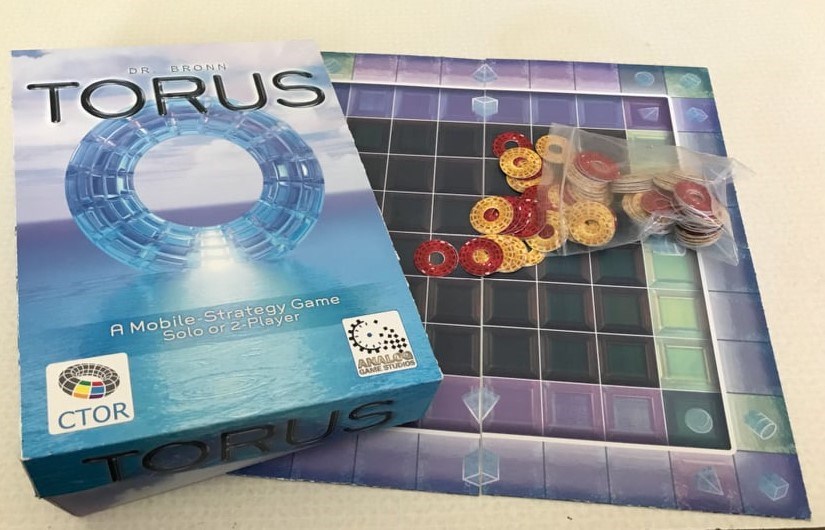If you are a fan of abstract strategy games you will know that far too often when a new game is created it invariably gets a comparison to chess tossed into the promotional material, and most simply don’t come up to that level.
In the case of Torus, the reference is at least less about game play, and a more general connection, noting that Torus is also a game of mental sparring as is chess.
That said, Torus does have something of an Othello-like feel, based on the fact you can ‘flip’ an opponent’s piece to your colour in the game as a core mechanic since you are trying to have the majority of pieces when the 64-squares on the 8X8 board are filled.
A piece is flipped when five of the eight squares surrounding the opponent’s stone are your colour.
That sounds rather straight forward, but in Torus you need to see the board as more of a sphere where a piece of the opposite of the board, along the far edge are actually adjacent.
Thanks to the torus shape, some of the tokens which can trigger a flip might actually be on the opposite sides of the board.
Understanding that spaces on opposites sides of the board are adjacent is critical to understanding the game of Torus. In order to help you be able to more easily see this wraparound adjacency, the Torus board has been designed in a special way in order to help you see which tokens are adjacent, notes the rules.
There is a set of spaces around the board that allow you to place markers to better visualize the Torus connections, which is a fine idea for new players, although not likely so essential for veterans of the game.
The rules are rather extensive explaining the ‘adjacency’ concept, which frankly makes it look far more daunting than it actually is.
While the idea of a wraparound board is interesting, it is not unique. The great game of Chase uses that mechanism to connect two of the four sides.
What is more daunting is how to best use the options presented to a player on each turn.
On your turn, you can do up to four different actions, called ‘operations’. You can do each operation once each turn, in any order, or skip one or more of them.
The most basic ‘operation’ is to place two tokens onto any open place.
You may also move two tokens one space each, or one token two spaces in an orthogonal direction (not diagonally).
From there is gets more interesting. A third operation is to remove any two of your tokens, and then place a token onto any free space.
This is intriguing, since it is often going to be more advantageous to remove a doomed piece (one you know will be surrounded), than to have it flipped. The other taken piece can simply be replaced, or at least there appears no rule against doing that.
The most complicated ‘operation; is migration, which allows the player to move a group of two, three or four tokens to adjacent free spaces.
With moves you can literally move off one edge ‘emerging on the opposite of the board.
After each operation, you check to see if you have surrounded one of your opponent’s tokens with at least five tokens of your own. If you have, flip it over to your own color, notes the rules.
Each time you flip over a token, check to see if this will cause any additional tokens to flip. Always remember to check for these cascading surround and flip actions. A single flip can lead to massive changes across the board.
With up to four actions a turn the board can change rather dramatically from turn to turn so planning a strategy is difficult, making Torus a game where you need to be adaptive turn-to-turn.
The game play is certainly interesting although if you fall behind it may be difficult to catch up, although since flips can cause a cascade of other flips, games are never totally hopeless.
The game comes with cardboard pieces and a board, or at least the copy I have, and while functional it is underwhelming.
A game like this begs for Othello-like pieces, a nicer, chunkier piece that feels good when С����Ƶ placed and moved.
If the game, you can find it via , finds an audience a nice production set would be a natural for the company to explore.




